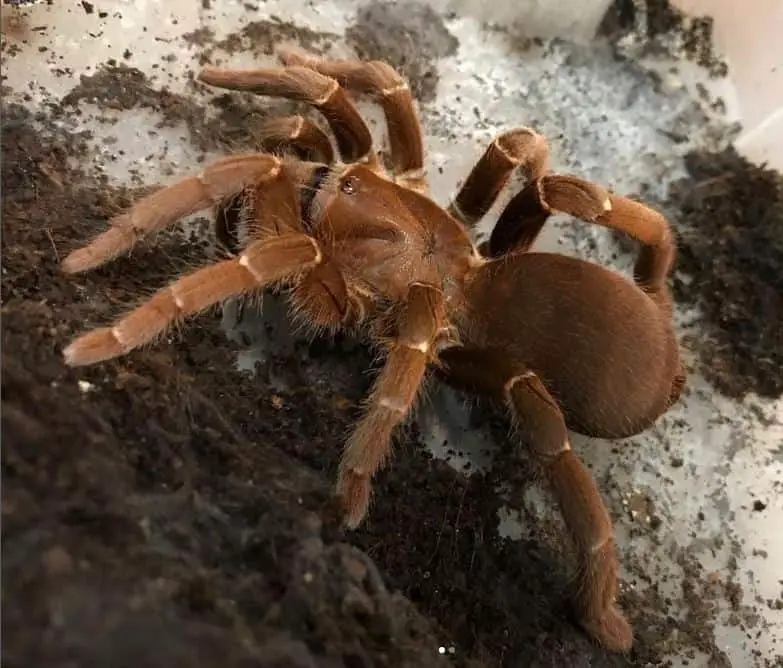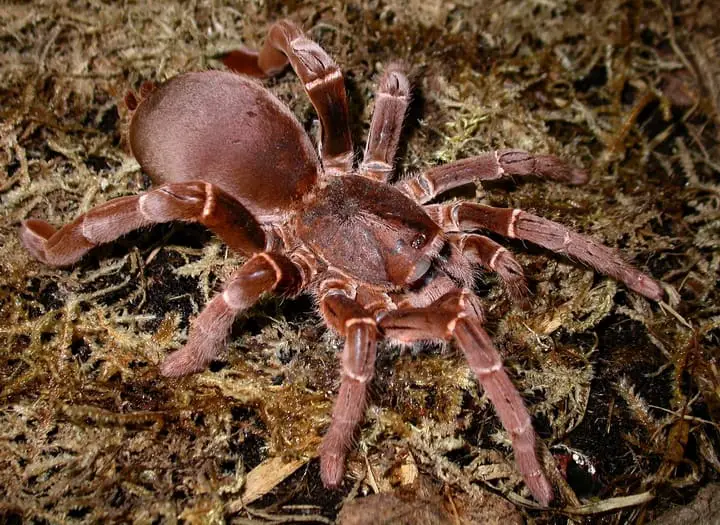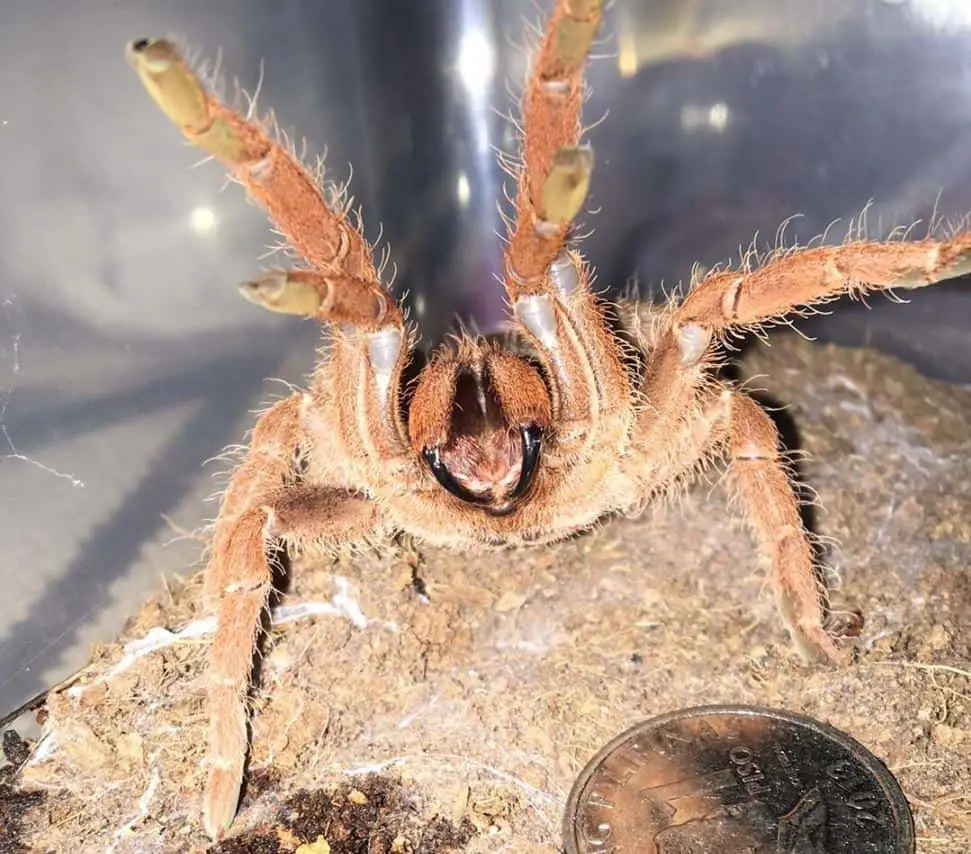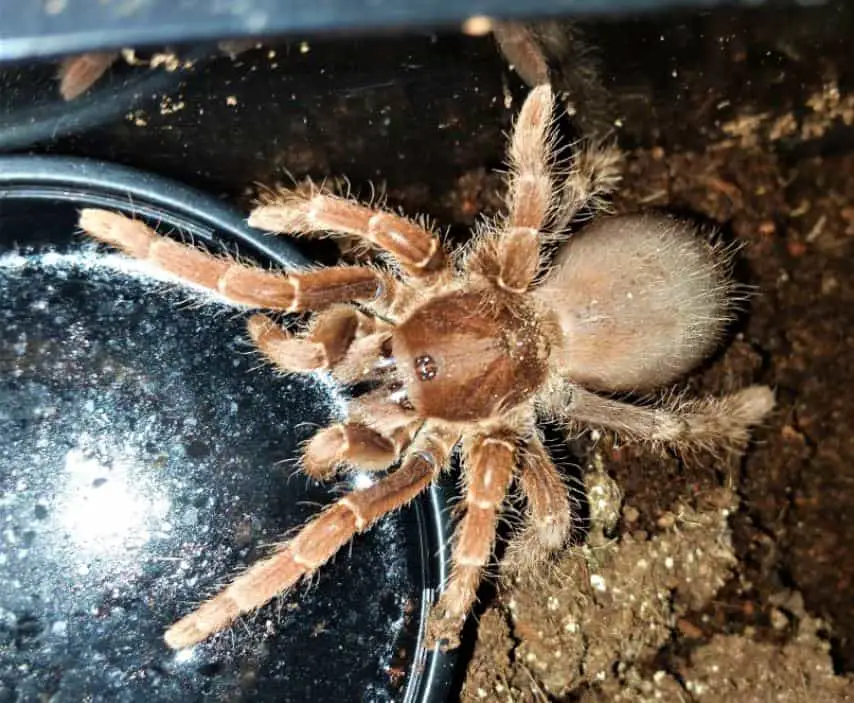The King Baboon Tarantula (Pelinobius Muticus) is also often referred to as the King Baboon Spider. This species is an exciting challenge for hobbyists. Their fearsome sizes and powerful bite makes them a tarantula you don’t want to mess with, and they are definitely not suitable for beginners to the hobby.
However, at the same time, it’s their size and the unique copper color that made them so popular in the hobby.
If you’re considering getting a King Baboon Tarantula for your collection, there are definitely quite a few things that you should know. We’ve compiled all the most prudent information for you in this guide to help you make the decision whether you’re ready to add the king of the baboon tarantulas to your collection.

King Baboon Tarantula Care Sheet
| Species Name | Pelinobius muticus |
| Family Name | Theraphosidae |
| Common Name | King Baboon Spider, King Baboon Tarantula |
| Category | Old World |
| Type | Terrestrial, obligate burrower |
| Native Location | East Africa |
| Leg Span | 8″ (20 cm) |
| Growth Speed | Slow |
| Urticating Hairs | No |
| Social | Solitary |
| Diet | Crickets, roaches, mealworms, and small rodents |
| Temperature | 68 to 78 degrees Fahrenheit |
| Humidity | 70 to 80%, though ventilation is more important |
| Life Expectancy | Female: 20 to 25 years / Male: 10 to 15 years |
| Experience required | Advanced! |
| Minimum tank size | 12″ x 12″ x 18″ |
King Baboon Tarantula overview
The Pelinobius muticus, commonly known as the King Baboon Tarantula or King Baboon Spider is an Old World species from East Africa, specifically, Kenya and Tanzania.
It’s a terrestrial opportunistic burrower, which means it’ll spend most of its time inside its burrow. The spider will spin silk in front of this burrow that helps it detect prey to ambush.
As is the case with many Baboon species, it’s a very defensive tarantula and prone to go on the offensive if something poses a threat to it. This spider is will not back down from a challenge.
In addition, this species is also unique because they’re capable of something called stridulation, a kind of sound some insects make by rubbing pieces of their bodies together. If you’ve ever heard crickets chirping, that sound is called stridulation.
Appearance

The King Baboon Tarantula is one of the biggest tarantulas in the world. In size, they lose only to very big species such as those in the Theraphosa genus and the Salmon Pink Birdeater. Fully grown, they can reach a leg span of almost 8 inches.
She’s known worldwide for her particularly long and angled hind legs. They also have massive fangs, which they’re not afraid to use.
This is a very bulky spider of a warm brown to orange color, similar to copper. The female specimens sometimes have a golden color in the joints of their legs.
Females are significantly larger than males, but there’s not a big difference in appearance between the two sexes.
Price
King Baboon Spiders are likely the slowest growers in the hobby. Some claim they take more than one year for one at certain points molt.
Their slow growth drives the cost of adult specimens up. Spiderlings can be found for around $60, and Younglings will cost $160 more or less. Sub-adults will be around $340 for males and $720 for females. Adult King Baboon females are some of the most expensive spiders in the hobby, sometimes fetching prices of up to $1600.
Behavior and Temperament

The King Baboon Tarantula is known to be aggressive and defensive. She’ll spend most of her time inside her burrow; however, her first instinct won’t be to run away to her burrow if she’s approached.
Instead, the King Baboon will always assume a threat posture and stridulate. You’ll learn to recognize that sound and take it as a warning not to get near it.
Like all Old World species, she doesn’t have urticating hairs, but she’s a fast mover and prone to bite. There are no known cases of lethal victims of their bite, but it’s still classified as one of the most painful venoms out of all tarantulas.
It’s inadvisable to handle this tarantula with bare hands due to how defensive they are and the potency of their venom.
Due to the fact that this spider is so defensive, she’s absolutely not recommended for beginners.
Caring for a King Baboon Tarantula

Temperature and Humidity
The King Baboon Tarantula lives in a vast region, but she’s found primarily on shrublands and grasslands.
Temperatures in their natural habitats go from 68°F to 93°F. It’s best to keep your King Baboon Tarantula at a temperature between 75°F and 84°F; also, their ideal humidity is between 60% and 70%. However, for this spider humidity is less important than ventilation.
Substrate
These very large obligate burrowers need plenty of room for their burrows. Spiderlings have enough with three inches of substrate, and juveniles should have at least four inches.
However, when we talk about adult King Baboon Tarantulas, they should have at least nine to ten inches of substrate to be comfortable.
They’ll spend most of their time burrowed, but they’re so big that the inside of their burrows is often visible through the tank’s walls, which makes them an excellent spider for display.
The materials aren’t too important as long as they’re high quality; a mixture of coconut fiber and dirt should be enough for them to be comfortable.
Tank
As a terrestrial species, these heavy spiders need a wider and longer tank than it is tall, and most of the tank’s height should be filled with substrate.
As spiderlings, they may be fine living in vials, and a three-gallon tank is good enough for juveniles, but adults need some of the greatest tanks in the hobby.
An ideal tank for an adult King Baboon Tarantula has a size of between fifteen and twenty gallons and has a secure lid to avoid escape.
For these spiders, it’s essential that the tank has enough holes for air to go through; ventilation is a dominant factor in their natural habitat.
The mighty King Baboon Tarantula doesn’t need a place to hide, because it will prefer to hide in its burrow, so bark, plants, and other decorations aren’t necessary. Nevertheless, if you want to make their enclosure more visually appealing you can place some rocks and plastic plants in their terrarium.
Watering
The King Baboon Spider lives in a dry natural habitat. Keeping the substrate wet isn’t that important. You can let water drip down one of the tank’s walls every couple of months and it’ll be comfortable for her.
Keeping a water dish inside her tank and refilling it when it gets dry is enough to hydrate the spider.
Social
Some tarantula species are social, but the King Baboon rules its kingdom alone. They do not like to share their enclosure with anyone else. Make sure that you never house two of them in the same enclosure because this will never end well.
Molting
The King Baboon tarantula is a slow grower and will therefore molt much less frequently than other species.
Nevertheless, they will of course still molt. Before they molt they will typically refuse food for a few days. Once the molting starts, it’s best to leave them be for a bit since this is a stressful time for them.
Once they’ve successfully completed their molt you shouldn’t feed them for several days because their fangs need time to harden.
Diet & Feeding
King Baboon tarantulas can eat large prey, which can be an interesting display of their power for hobbyists.
Spiderlings should eat a small cricket or a flightless fruit fly every four to seven days.
Depending on their sizes, juveniles could eat two medium crickets, one earthworm, or a small roach every four to seven days.
Adults have a healthy appetite and will try to eat anything they can subdue, so there’s a great variety of prey you can feed them every seven to ten days. Large cockroaches, locusts, large crickets, and even small mice are among their preferred prey.
It’s advisable not to feed them mice too often and instead prioritize insects to resemble the regular diet they’d get in their natural habitat.
These tarantulas have a healthy appetite. Make sure that you do not overfeed them by keeping an eye on the size of their abdomen. If it gets too big you might want to reduce their food intake a bit.
Health & Lifespan
The King Baboon Tarantula has a long lifespan. Females can live for up to 25 years. Even males, which typically live quite short lives can live for up to 15 years.
The King Baboon is generally a healthy species. As long as you care for them properly it should not be difficult for them to thrive in captivity. Some things to look out for in order to keep the tarantula in good are parasites, mold growth, and spider mites. These problems can be avoided by keeping their enclosure clean, removing uneaten food, and ensuring that they have ample ventilation.
Breeding King Baboon Tarantulas
Males are smaller and weaker than females, so breeding is a very dangerous enterprise for a male KBT. However, most breeding attempts happen inside the burrow, so it’s almost impossible to try to save a male, and the only way to defend him is to make sure both specimens are well-fed.
Even in that case, females are very aggressive and will likely attack anything that comes near them, so if they’re not interested in breeding, they’ll try to kill the male as soon as he approaches. If, however, the mating occurs, the female should be fed three times per week until the egg sac is produced.
This may take four to eight weeks after mating. The King Baboon Tarantula is a protective mother, so it’s better to let the offspring stay with her until they hatch and start to spread around the enclosure. Then, you’ll be able to take them and grow them separately.
Do note though that breeding should only be done by breeders. Hobbyists shouldn’t randomly start breeding tarantulas because you’ll end up with hundreds of slings that will be very difficult to care for and find homes for.
King Baboon Tarantula Facts
- The Pelinobius muticus is the only member of the Pelinobius genus.
- the King Baboon tarantula was first described in 1885 by Ferdinand Anton Franz Karsch.
- This is one of the few species that uses stridulation as a means of defense
Final words: Is the King Baboon the right tarantula for you?
The King Baboon Spider may seem intimidating at first sight, but she’s a very rewarding pet that’s the pride and joy of many hobbyist’s collections.
If you’re new to the hobby though or even have some intermediate experience, this species is not recommended due to their defensive nature and potent venom. They’re named the King of the Baboon spiders for a reason. Only get one if you’re sure you can keep up with them.
We hope this information helped you make the right decision about whether this marvelous tarantula is the right fit for you.
If you’re new to the hobby and are looking for some beginner-friendly species, check out the Chaco Golden Knee, Metallic Pink Toe, or Mexican Red Rump Tarantulas.
- How Long Do American Eskimo Dogs Live? Important Factors and Care Tips - September 29, 2023
- Do American Bulldogs Need Grooming? Essential Tips and Care Guidelines - September 29, 2023
- Do Bengal Cats Enjoy Playing? Essential Tips for Keeping Them Active - September 29, 2023